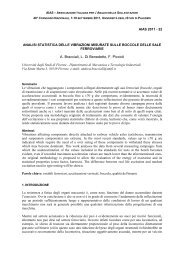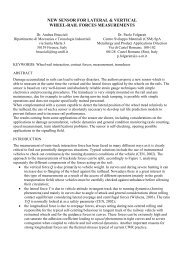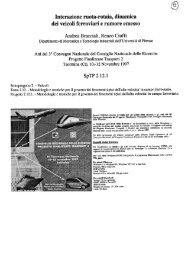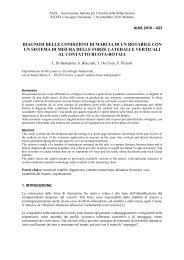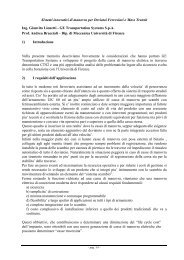LOW NOISE WHEEL - Home page Andrea Bracciali
LOW NOISE WHEEL - Home page Andrea Bracciali
LOW NOISE WHEEL - Home page Andrea Bracciali
You also want an ePaper? Increase the reach of your titles
YUMPU automatically turns print PDFs into web optimized ePapers that Google loves.
9. PANEL STRENGTH AT THE END OF <strong>WHEEL</strong> LIFE9.1 Syope ® wheel recovery at the end of their lifeAlthough external loads on the panel are mainly centrifugal and are supported by themechanical structure of the panel (whose elasticity modulus is much greater than that of thepolymer) and by the constraints given by the shape of the wheel web, some concernsremained about the effective durability of the treatment in real service.Of the whole set of wheels installed in 2000 under ETR500 PLT-51, four wheelsets, i.e. thosemounted on 1 st Business Class Coach #6 (number 90 83 5 899 207-5, both bogies with Syope ®wheels), finished their life under ETR500 PLT-56, were returned to Lucchini plant in Lovereand were treated as normal steel scrap.Thanks to the cooperation with the Maintenance structure of Trenitalia, it was instead possibleto monitor the status of other four wheels, i.e. those mounted on 1st Class Coach #7 (number90 83 5 199 212-2, one bogie with Syope ® wheels). These wheels where collected at theTrenitalia Workshop in Vicenza at the end of July 2005 at the end of their useful life, i.e1.100.000 km and five years after they were mounted in 2000.Once again, Trenitalia recognized [20] that the use of Syope ® wheels had been absolutely“transparent” to the final user, also on a high value train that was regularly inspected: “Aboutmaintenance aspects, the life cycle of mentioned wheelsets was absolutely identical to that ofall the other wheelsets used on ETR500 trains…”. Nevertheless, an overview of the panelconditions in the workshop showed that external panels had some parts that were apparentlydetached. It was decided to keep the wheels back to Lucchini Sidermeccanica laboratories inLovere to verify, after a full life, the final conditions of the constraining panel.9.2 Panel tear tests at the end of wheel lifeAs the external action on panel is due to the combination of the centrifugal force and verticalvibrations (peak and random) induced by actual wheel rolling on actual rail, it is readilyunderstood that these actions can never produce a detach of the panel. It was thereforenecessary to “invent” a test procedure that had no resemblance with reality trying to tear offthe panel from the wheel web. Several decisions were taken:- the external action should have been able to detach the panel from the wheel, i.e. it hadto be applied along the wheel axis;- no mechanical action was permitted on the panel before the external action is applied,i.e. it is not possible to make bores, threads or other fixing surfaces;- no thermal loads had to be applied on the panel, i.e. any welding to the panel isforbidden.The only possibility left was to bond a disk on the inner border of the panel, where the surfaceis minimum and hence the possibility of detaching the panel is maximum. A structural gluewas chosen and two rings, one for the internal panel and one for the external panel, wereprepared. The rings were rigid enough to avoid deformation during tension tests and werepulled by a statically determinate system of chains and rings. The system is shown in Figure12 and in Figure 13.Figure 12. Tear test preparation. Left: the glue is applied to the internal ring. Mid: curingtime was min. 24 hours. Right: Universal traction machine with Syope wheel mountedready for tear test.



